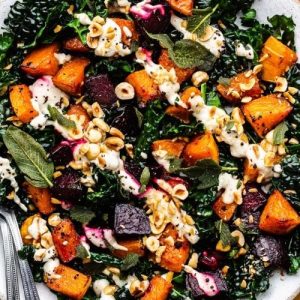This roasted vegetable salad is a colorful, wholesome dish that combines caramelized root vegetables, tender kale, and a creamy garlic dressing.
Packed with fiber, plant-based protein, and heart-healthy fats, it’s both nourishing and satisfying while staying low in saturated fat.
The mix of sweet beets, nutty squash, and crunchy hazelnuts makes it a balanced, flavor-rich option for everyday cooking—perfect for weeknight meals, festive gatherings, or meal-prep lunches.

Flavor-Packed Roasted vegetable salad
Equipment
- 1 Large Baking Tray
- 1 Small frying pan (for sage, optional)
- 1 Small blender (for dressing)
- 2 Mixing Bowls
- 1 sharp knife
- 1 cutting board
- Kitchen foil or baking paper (for garlic)
Ingredients
For the Salad
- 100 g 3.5 oz kale (lacinato/Tuscan kale preferred)
- 250 g 9 oz / 2 medium beetroots, peeled and cubed
- 500 g 17.5 oz / ½ medium butternut squash, peeled and cubed
- 1 whole garlic head
- 2 tbsp 30 ml balsamic vinegar
- 2 tbsp olive oil plus extra for kale
- Salt and black pepper to taste
- 50 g ½ cup roasted hazelnuts, chopped
- 8 fresh sage leaves optional, for frying
For the Creamy Garlic Dressing
- 70 g ½ cup cashews or sunflower seeds, soaked*
- 120 ml ½ cup water
- 1½ tbsp 20 ml apple cider vinegar
- 1 tsp 5 ml maple syrup or brown sugar
- 2 tsp wholegrain mustard
- Roasted garlic cloves from above
- Salt to taste
Instructions
- Preheat the Oven and Prepare Equipment: Begin by preheating your oven to 225ºC (435ºF) so it reaches the correct temperature by the time your vegetables are ready to go in. Line a large baking tray with parchment paper or lightly grease it with olive oil to prevent sticking. Gather all your ingredients and equipment—this makes the cooking process smoother and ensures you don’t miss anything once you get started.
- Prepare the Vegetables for Roasting: Peel the butternut squash and beetroots, then cut them into evenly sized cubes, about 2 cm (¾ inch). Keeping the pieces uniform ensures they cook at the same rate and develop a nice caramelized exterior without burning. Place the squash cubes in one bowl and the beetroot cubes in another, as this keeps their colors from bleeding into each other while prepping. Toss each vegetable with a drizzle of olive oil, season generously with salt and pepper, and stir well to coat every piece.
- Prepare the Garlic for Roasting: Take a whole head of garlic and trim off just the top to expose the cloves inside. Place it on a small piece of foil or parchment paper, drizzle lightly with olive oil, and wrap it up securely. This prevents the garlic from burning while allowing it to soften and roast evenly, turning it into a sweet, mellow version of itself. Place the wrapped garlic onto the baking tray alongside the vegetables.
- Roast the Vegetables Until Caramelized: Spread the prepared squash and beetroot cubes in a single layer on the baking tray, keeping them separated if possible. Place the tray in the oven and roast for about 20 minutes. After this initial roasting, remove the tray briefly, transfer the vegetables back to their mixing bowls, and toss each with about 1 tablespoon of balsamic vinegar. Return them to the tray and roast for another 10–15 minutes, or until they are tender, slightly caramelized on the edges, and glistening with flavor.
- Massage the Kale for Tenderness: While the vegetables are roasting, prepare the kale. Remove the tough stems and chop the leaves into bite-sized pieces. Place the kale into a large mixing bowl or directly onto your serving platter. Drizzle with about 1 teaspoon of olive oil and sprinkle lightly with salt. Using clean hands, gently massage the kale by rubbing the leaves together for 1–2 minutes. This process breaks down the fibrous texture, softens the leaves, and makes them easier to digest, all while enhancing their natural flavor.
- Make the Creamy Garlic Dressing: Once the garlic is roasted and cool enough to handle, squeeze the soft cloves out of their skins into a blender. Add the soaked cashews or sunflower seeds, ½ cup of water, apple cider vinegar, maple syrup, mustard, and a pinch of salt. Blend until completely smooth and creamy. Taste and adjust seasoning—add more salt for depth, a little extra vinegar for brightness, or a drop more maple syrup if you’d like a touch of sweetness. The dressing should be silky, pourable, and bursting with roasted garlic flavor.
- Optional Step: Fry the Sage Leaves: If using sage, heat 1–2 tablespoons of olive oil in a small frying pan over medium heat. Once the oil is shimmering, carefully add the sage leaves in a single layer. Fry briefly for about 30 seconds, just until they crisp up. Immediately remove them with tongs or a slotted spoon and place on a paper towel to drain. Sprinkle lightly with salt—they will continue to crisp as they cool. Save the sage-infused oil for drizzling over salads, roasted vegetables, or mashed potatoes another time.
- Assemble the Salad: On your serving platter, start with a generous layer of massaged kale as the base. Arrange the roasted beets and squash evenly across the top so the colors are beautifully distributed. Drizzle the creamy garlic dressing generously over the salad, making sure some dressing coats the kale while leaving some to pool around the roasted vegetables. Sprinkle with chopped roasted hazelnuts for crunch and scatter the crispy sage leaves on top if using.
- Final Touches and Serving: For the best flavor, serve the salad slightly warm so the contrast between roasted vegetables and tender kale is most enjoyable. This dish works beautifully as a holiday centerpiece side, a nourishing weekday lunch, or even a light main course when paired with crusty bread. Store any leftovers in the fridge in an airtight container, keeping the dressing separate if possible, for up to 3 days.
Notes
- Vibrant, colorful roasted vegetable salad packed with flavor and texture.
- Sweet roasted beets and butternut squash perfectly balance the earthy bitterness of kale.
- Creamy garlic dressing adds richness and ties all ingredients together.
- Toasted hazelnuts provide satisfying crunch, while crispy sage offers a delicate, aromatic finish.
- Gluten-free, versatile, and suitable for everyday meals or festive occasions.
- Can serve as a side dish or a light main with bread or protein additions.
Chef’s Secrets for Best Results
The secret to a truly memorable roasted vegetable salad lies in three details: even roasting, proper kale preparation, and a balanced dressing.
Cutting your vegetables into uniform cubes ensures they roast evenly and develop a sweet, caramelized flavor without burning.
Massaging kale with a touch of oil is not just a quirky step—it’s essential for breaking down tough fibers and making the leaves tender and digestible.
Finally, a creamy dressing with acidity, richness, and a touch of sweetness elevates the salad from simple to exceptional.
Don’t rush the garlic roasting; its mellow flavor is the heart of this dish.
Delicious and Versatile Serving Suggestions
This salad shines as a warm side dish for family dinners or festive gatherings, but it’s also hearty enough to serve as a main course with crusty bread or warm pita.
For added protein, pair it with roasted chickpeas, lentils, or grilled tofu. It complements rich holiday mains like nut roasts, baked casseroles, or stuffed squash, offering a refreshing balance of flavors.
If you’re making it for lunch, pack the kale and roasted veggies separately and drizzle the dressing just before eating to keep the texture fresh.
Smart Storage and Make-Ahead Tips
This salad is highly meal-prep friendly. Store the roasted vegetables, massaged kale, and dressing in separate airtight containers in the refrigerator for up to 3 days.
This prevents sogginess and keeps each component fresh. The dressing may thicken slightly in the fridge, so whisk in a splash of water before serving to restore creaminess.
Hazelnuts and fried sage are best added just before serving to maintain their crunch.
For convenience, you can roast the vegetables a day ahead and assemble the salad right before serving.
Frequently Asked Questions
1. Can I use different vegetables?
Absolutely! While beets and squash are classic choices, this recipe is very flexible.
Carrots, parsnips, sweet potatoes, or even pumpkin work beautifully.
Choose vegetables with natural sweetness, as they balance kale’s bitterness well.
2. Do I have to use kale?
No. If kale isn’t your favorite, try baby spinach or arugula.
Just remember these greens are more delicate and should be added right before serving, as they can wilt when paired with warm vegetables.
3. What if I don’t have cashews?
No problem—sunflower seeds are a great nut-free alternative. If you prefer not to soak anything, substitute with tahini.
Simply mash the roasted garlic with a fork before stirring it in for a silky texture.
4. Can I make this salad ahead of time?
Yes! You can roast the vegetables and prepare the dressing a day in advance.
Keep everything stored separately in the fridge and assemble just before serving.
This makes it a stress-free option for holidays or dinner parties.
5. How can I make this salad more filling?
To make it a complete meal, add a grain or protein.
Quinoa, farro, or couscous bring extra fiber, while chickpeas, lentils, or grilled tempeh provide protein.
These additions make the salad hearty enough for lunch or dinner.

